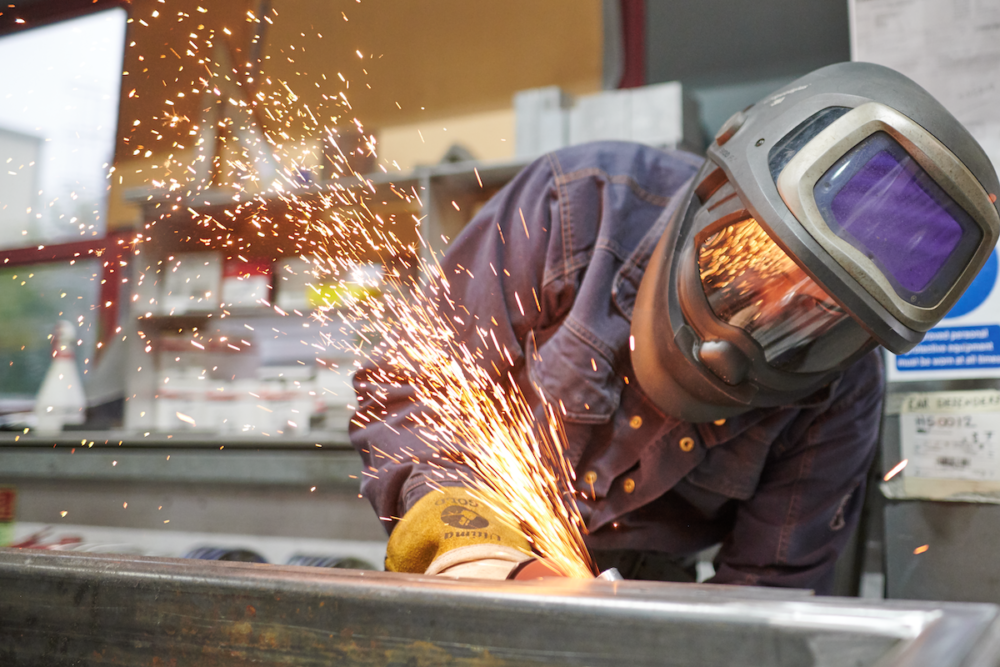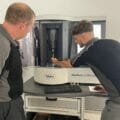By Gareth Anderson – Head of Business Management, Allica Bank.
Banks and the lending community have a vital role to play in supporting the UK’s economic recovery, and this is especially true in the manufacturing sector. They need to continue to innovate and adapt products to match the needs of established small- to medium-sized enterprises (SMEs) and deliver levels of service and support to ensure customers maximise the leverage available to them.

Gareth Anderson – Head of Business Management, Allica Bank
This support requires not only a proximity to the customers they serve, but also being able to demonstrate a deep understanding of the challenges their customers face. And the UK manufacturing sector currently faces a number of headwinds that show no immediate signs of abating.
Heading backwards
The Purchasing Managers’ Index (PMI), compiled by S&P Global, gives a monthly figure to gauge the overall health of the economy by analysing GDP, inflation, exports, capacity utilisation, employment and inventories. Any score above 50.0 shows an economy in positive health; under 50.0, and the economy is effectively heading backwards.
Whereas the composite PMI score was positive (at 54.0), manufacturing was in the negative (47.1). Of greater concern, is that 47.1 represents a drop from the previous month (47.8) and trails a period of continual decline. It means that based on such vital measurements as new orders, output, employment, supplier delivery times, and stock of items purchased, the manufacturing sector is contracting. (Source – Markit/CIPS UK Manufacturing Purchasing Managers’ Index May 2023).
The statistics lay bare the pressures that manufacturers are under. Weaker demand combined with mounting costs are creating a near perfect storm, and the economy is staring down the barrel of stagflation brought about by rising prices, a stubborn inflation rate and only sluggish growth. A full recession may be avoidable, but with expected growth only just hovering above 0.1%, it wouldn’t take much of a shock for the economy to go into reverse.
Pressures on costs – not least the rising cost of energy – are joined by other challenges conspiring to make a difficult situation worse. Whilst wholesale energy prices have come down from their peak in the summer, many businesses still find themselves paying considerably more for their electricity and gas than they were two years ago. Raw material supply challenges are also continuing, with a shift away from low-cost global supply chains towards regional and cluster-focused supply chains driven by the need for greater reliability: companies are near shoring, bringing manufacturing closer to the point of demand and localising supply.
Vicious circle
As manufacturers adapt their supply chains, the competition for resources and raw materials has intensified, and some materials continue to be in short supply. Resource shortages naturally push up prices and creates something of a vicious circle, obliging manufactures to secondary source where possible and find alternative suppliers. This is easier said than done, however, and in some industries – especially those that are tightly regulated – it is not a simple case of swapping out one material or product for another. There are also investments required in re-tooling and the re-engineering of processes that result.
Global uncertainty has also brought about cost inflation. In the short term, this impact can only be mitigated through ‘quick win’ productivity improvements or price increases. In the longer term, customers and consumers may have to accept that higher supply chain costs are a necessity to achieve greater reliability; and this will likely translate into higher prices.
In the UK, growth will depend on the long-term impact of Brexit and future trade agreements, as well as having the right incentives in place. Lead times have slowed between the UK and mainland Europe since Brexit, making the UK a less attractive place to locate manufacturing. Those who do manufacture are frustrated by barriers and frictions that increase their cost to trade, making it harder to export the good they make, and import the materials they need to keep the production lines rolling.
Supply chain issues are not likely to disappear any time soon. Indeed, a State of Manufacturing Report by Essentra PLC earlier this year suggests that almost two thirds (60%) of manufacturers expect supply chain issues to last for at least another five years. Agile planning, it suggests, and effective processes to manage and respond to unforeseen supply chain challenges will need to become the ‘norm’, not the exception, and will become a driver of competitive advantage.
Staff shortages
To the material and supply chain difficulties are added the challenge of talent and recruitment. Put simply, a tight labour market is making the recruitment and retention of good people increasingly problematic.
COVID prompted many to leave the sector, never to return, (some suggest as many as 200,000 have left manufacturing since 2010, down from 2.9 million to 2.7 million today), and a new generation of employees simply don’t want to work in manufacturing. Partly this is because manufacturing has an image problem, but also the emergence of a gig economy has changed the way people work and their expectations for future employment. Those who are engaged can demand greater salaries, not only because their talents are in short supply, but also because inflation requires their salaries to increase so their wages don’t go backwards.
Geo-political uncertainties also need to be factored into the general state of play: the UK/EU trading relationship, for example, is still unclear; China/US relations – notwithstanding recent meetings – are a challenge; and the Ukraine/Russia crisis shows no sign of being resolved any time soon. As one commentator recently wrote, the very benign days of the last 10 years are behind us, and to each of these challenges, all manufacturers can do is react.

The need for certainty
What all manufacturers need right now, however, is certainty. They want to see a formalised and agreed Industrial Strategy from Government and they want to see decisive action in bringing inflation under control and interest rates to a more sustainable level. Whereas consumers have been alerted to interest rate hikes only comparatively recently, manufacturers have been sensitive to them for some time. When interest rates rise, investing in new plant, machinery or premises becomes far less attractive as the cost of borrowing increases, stretching the return-on-investment horizon to a place many don’t want to go.
It would be wholly wrong, however, to characterise all of UK manufacturing as being in a state of stagnation or even decline. In any market, where there are those who lose, there are others who win, and the winners are especially those who have pivoted their businesses to focus on many of the ‘newer’ industries involving electrification and similar ‘Green’ technologies. Indeed, many of those businesses are in rude health, and will be key to returning the UK to more positive growth.
Manufacturers that have built resilience into their business models and who can flex and adapt with the challenge of uncertainty still create opportunities. No SME ever says they want to stand still; every manufacturer is looking to grow, and for that they must have the confidence to invest.
This is where the banks come in, not only to provide the money, but also the knowledge and the connections to help build a sustainable business.
There will be those manufacturers, for example, who have yet to really think about investing in more energy efficient processes or buildings, and the positive impact this can have on their bottom line. There are others who have never borrowed in their lives, and perhaps even fear debt, and yet could benefit significantly from borrowing to invest in new energy efficient technology that would not only improve their production capacity, but also reduce costs to such an extent that it delivers a timely and tangible return on investment. Debt is not for everyone, but for profitable businesses, with a healthy balance sheet, and a very clear plan of what that borrowing is going to fund and the return they can expect it can be a sound business decision.
Shifting models
As well as investing in plant and machinery, manufacturers may also be looking to shift their model of leasing their premises to acquiring their own. Again, it may not be for everyone, but taking on a commercial mortgage to acquire a new, more modern premises that has been built specifically with the purpose of being more energy efficient can similarly be transformative.
Getting started can be a headache. Manufacturers may recognise a direction of travel towards a greener, more energy efficient future, but are not sure how to get there. Again, this is where banks can step in, not as ESG consultants, but rather by embracing their wider relationships and working collectively and collaboratively with their customers and partners to deliver more holistic solutions.
It is not enough for banks simply to be order takers. The more successful banks are those with Relationship Managers in the field who take the time to better understand their customers, the people behind the business, their motivations and ideas, and their strategies for future growth. Then it is about connecting them to a wider ecosystem that can help them improve supply chain efficiencies, find new business opportunities, and deliver the funding they need to grow.
Throughout COVID, many manufacturers stockpiled large amounts of cash – cash that is now sitting in a bank account, earning nothing and doing less. Whereas banks may have increased their interest rates on their savings products, current accounts and instant access accounts have remained flat.
This has presented a huge opportunity for the challenger banks, and Allica Bank in particular, which recently launched its own business current account paying 3% interest without any penalties for early withdrawal, or limits on what can/cannot be taken out. For a manufacturer with £1 million in the bank, that’s £15,000 in interest earned while the money sits there, perhaps ring-fenced to pay a future HMRC bill or as a deposit for some new machinery.
Even as recently as five years ago, we would not have been having conversations with manufacturers about their savings or excess cash balances. But times have changed, and the smarter banks have changed with them. Standing still is in fact going backwards. Supporting established SMEs with a comprehensive portfolio of asset finance, commercial mortgage, and current account products complemented by a network of Relationship Managers who truly get under the skin of the businesses they support will be key in moving the needle of a future PMI index in the right direction.





